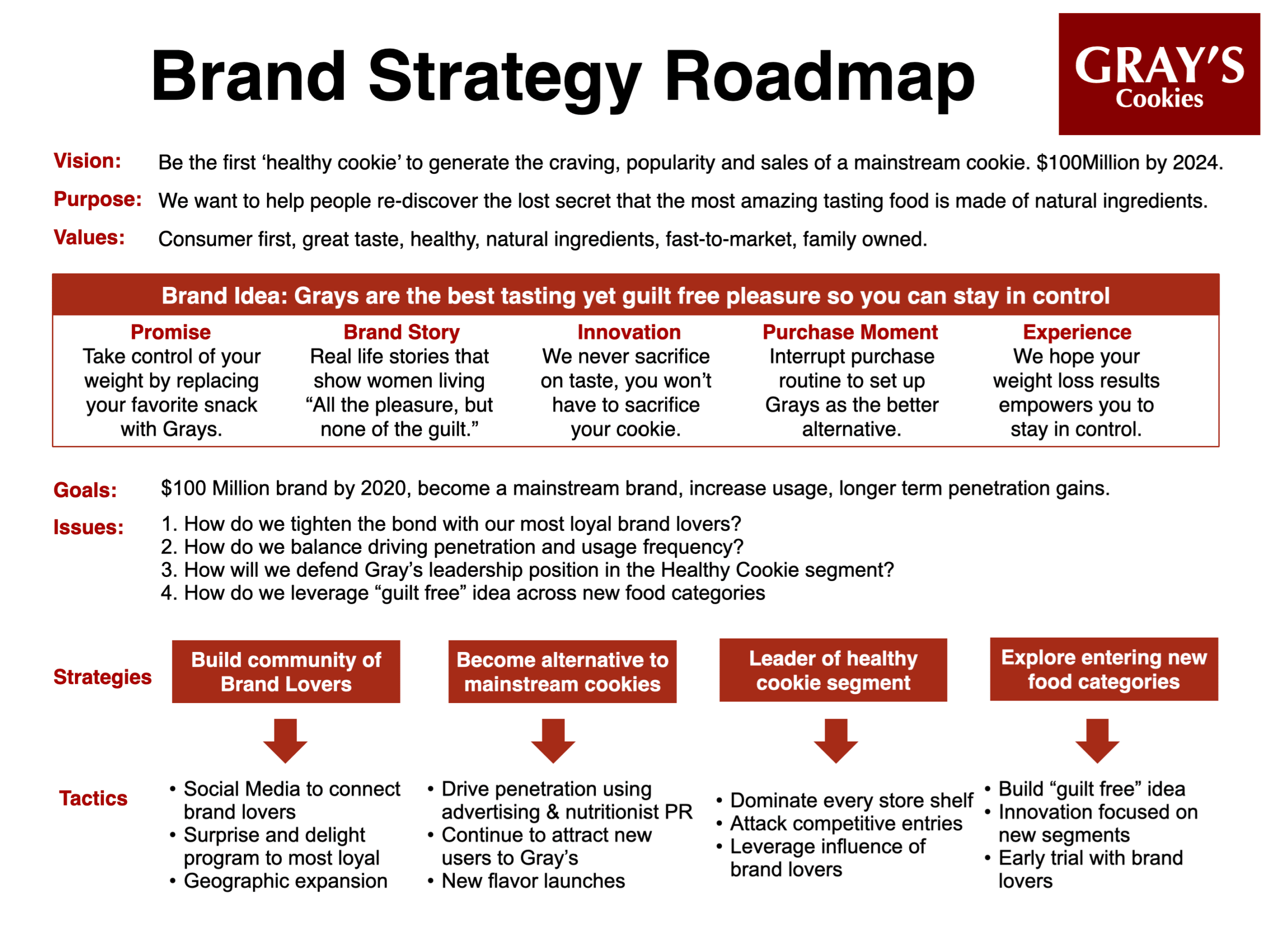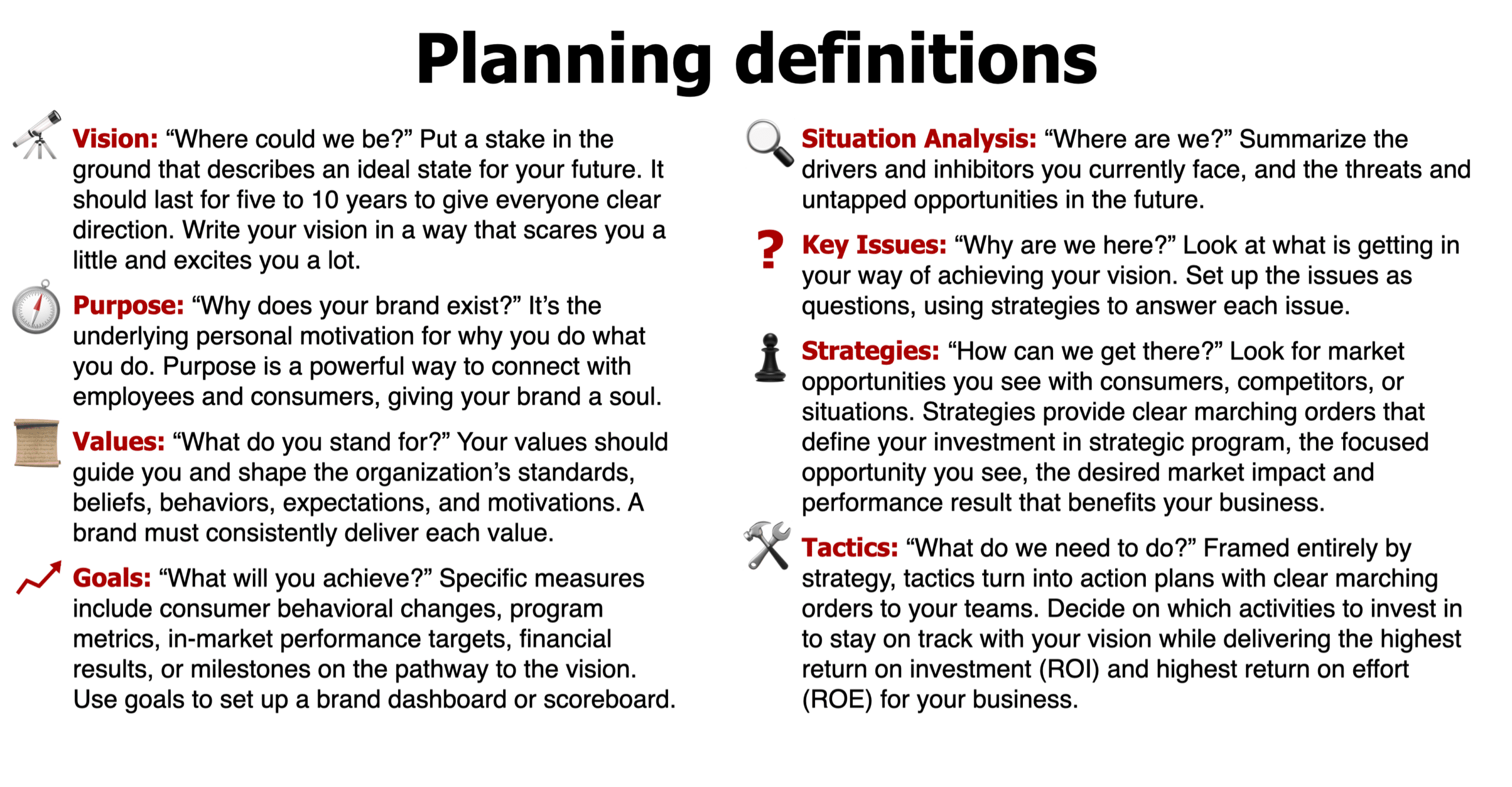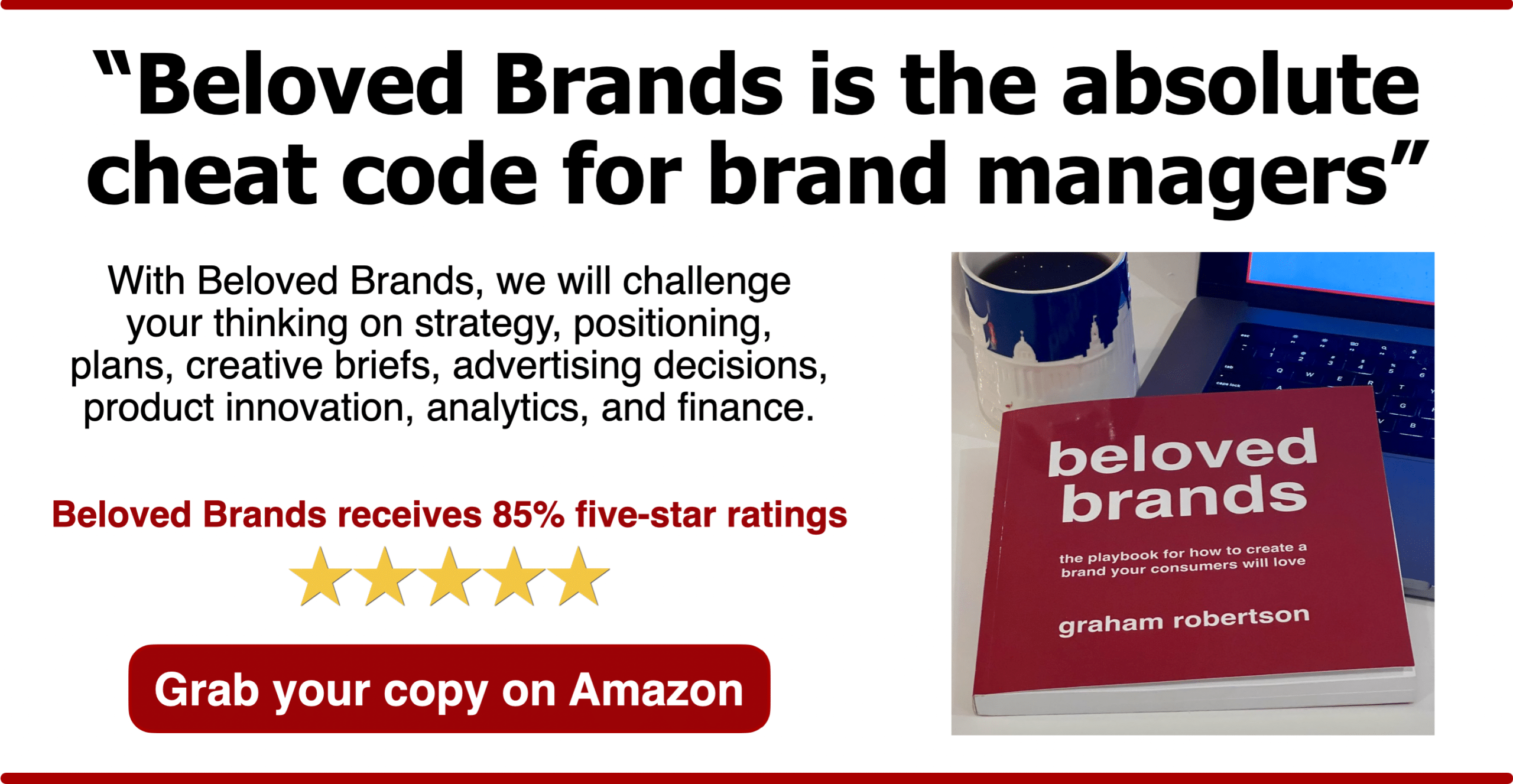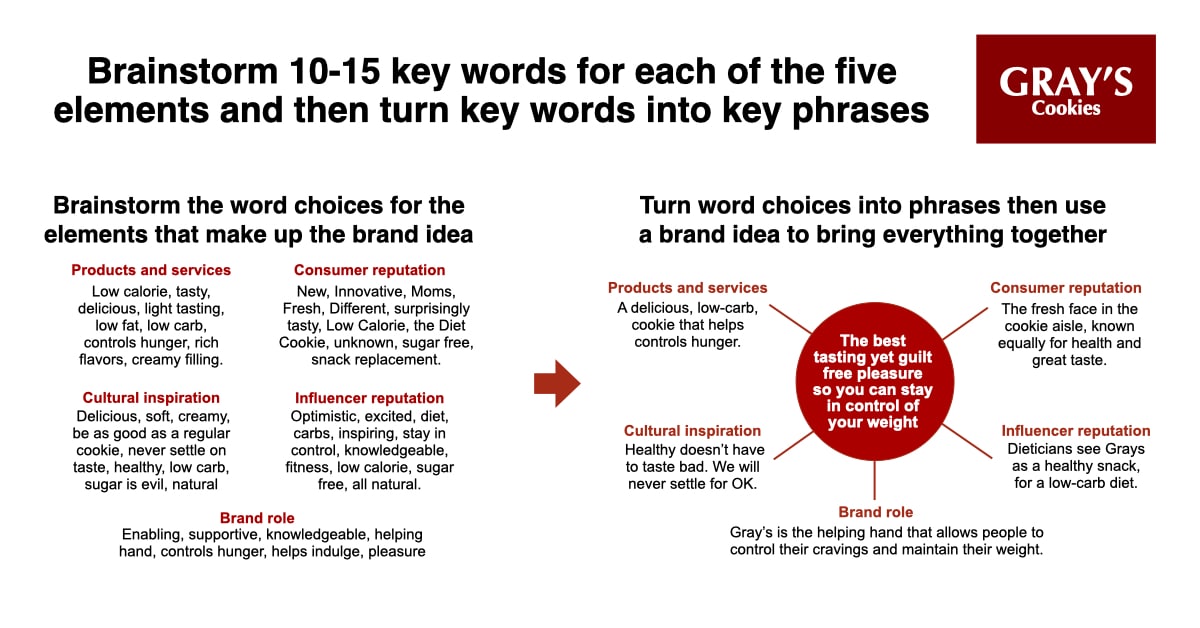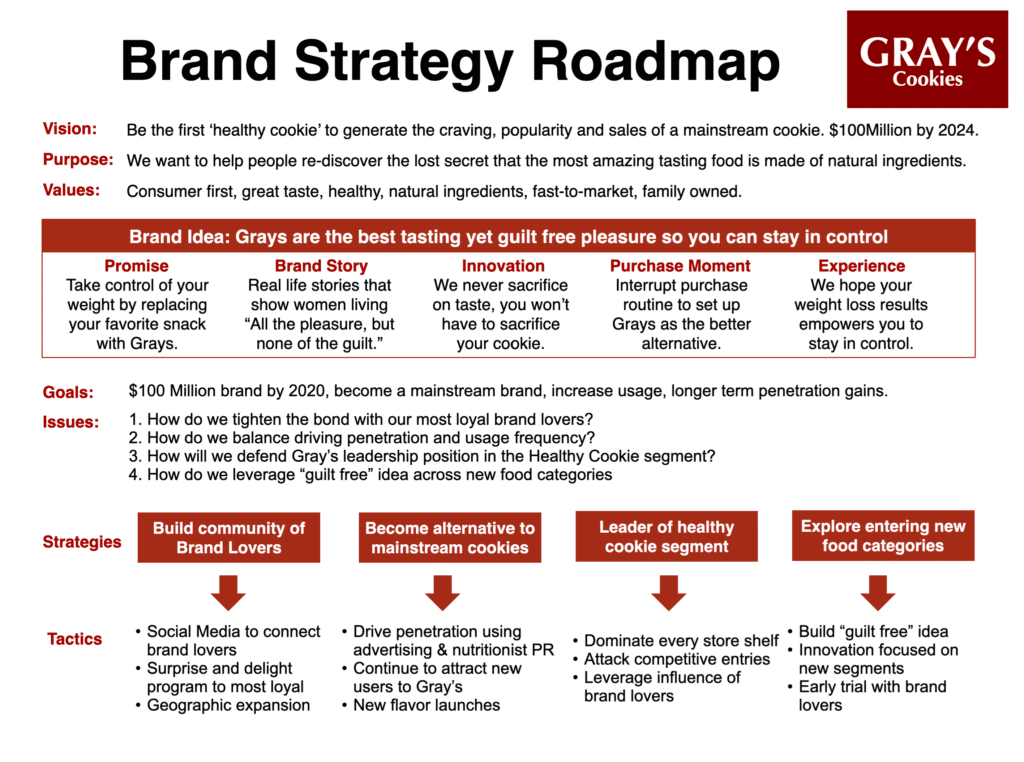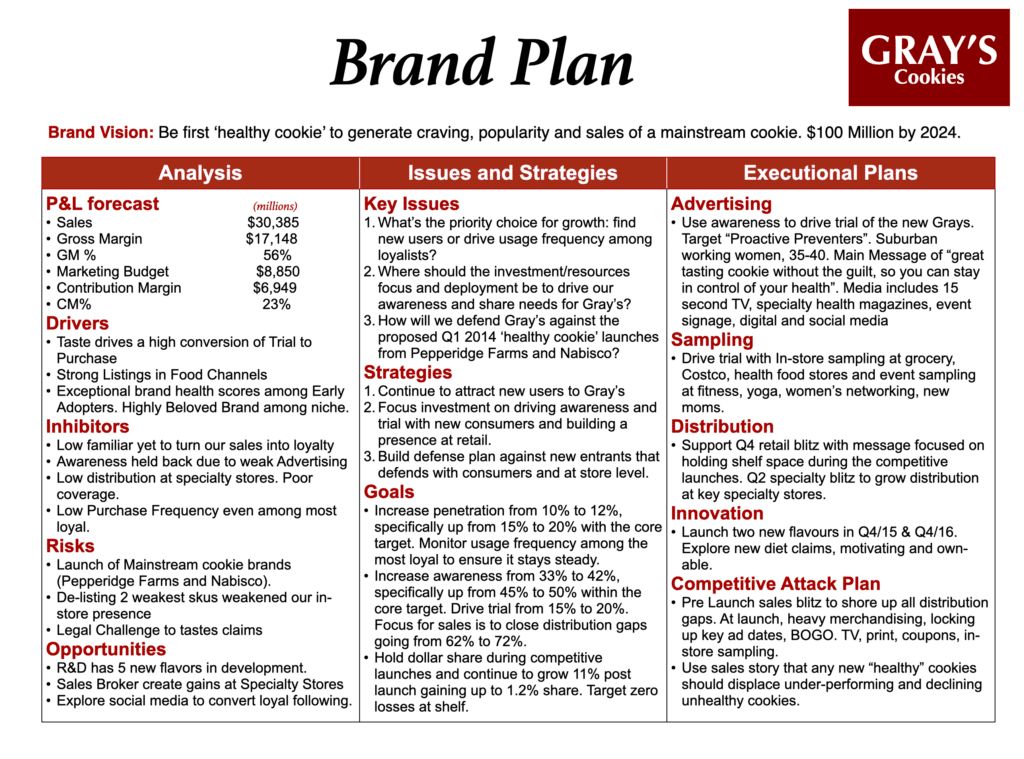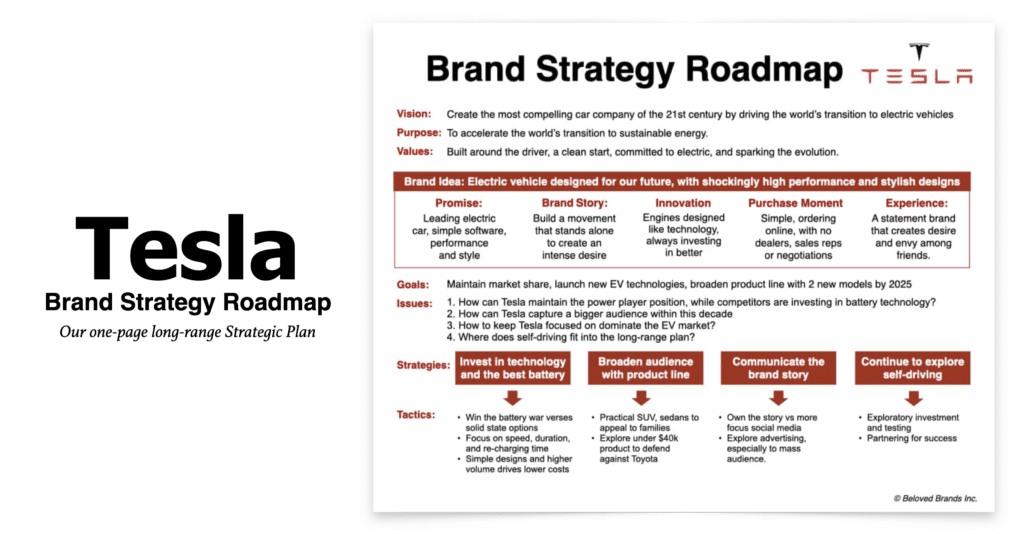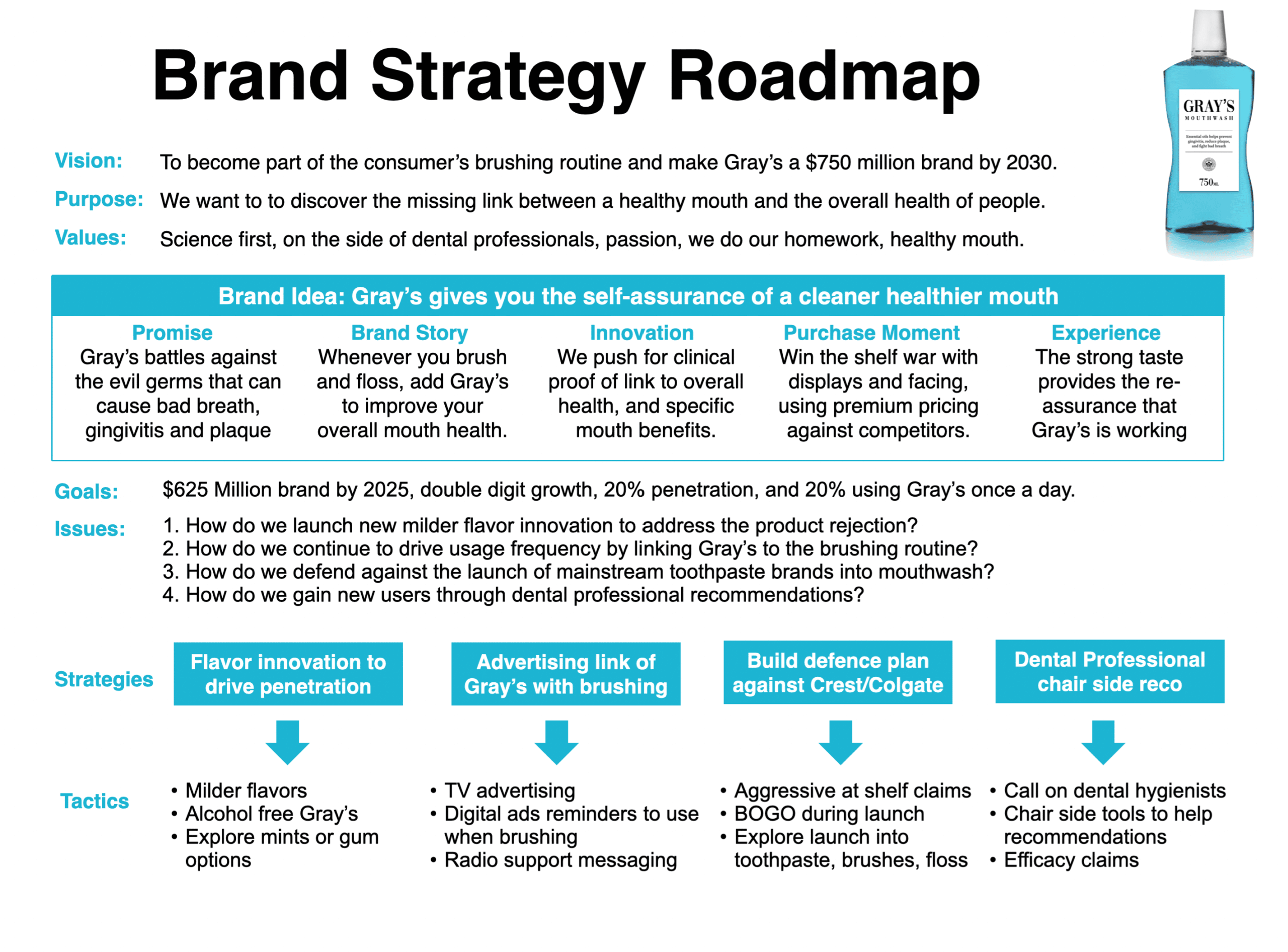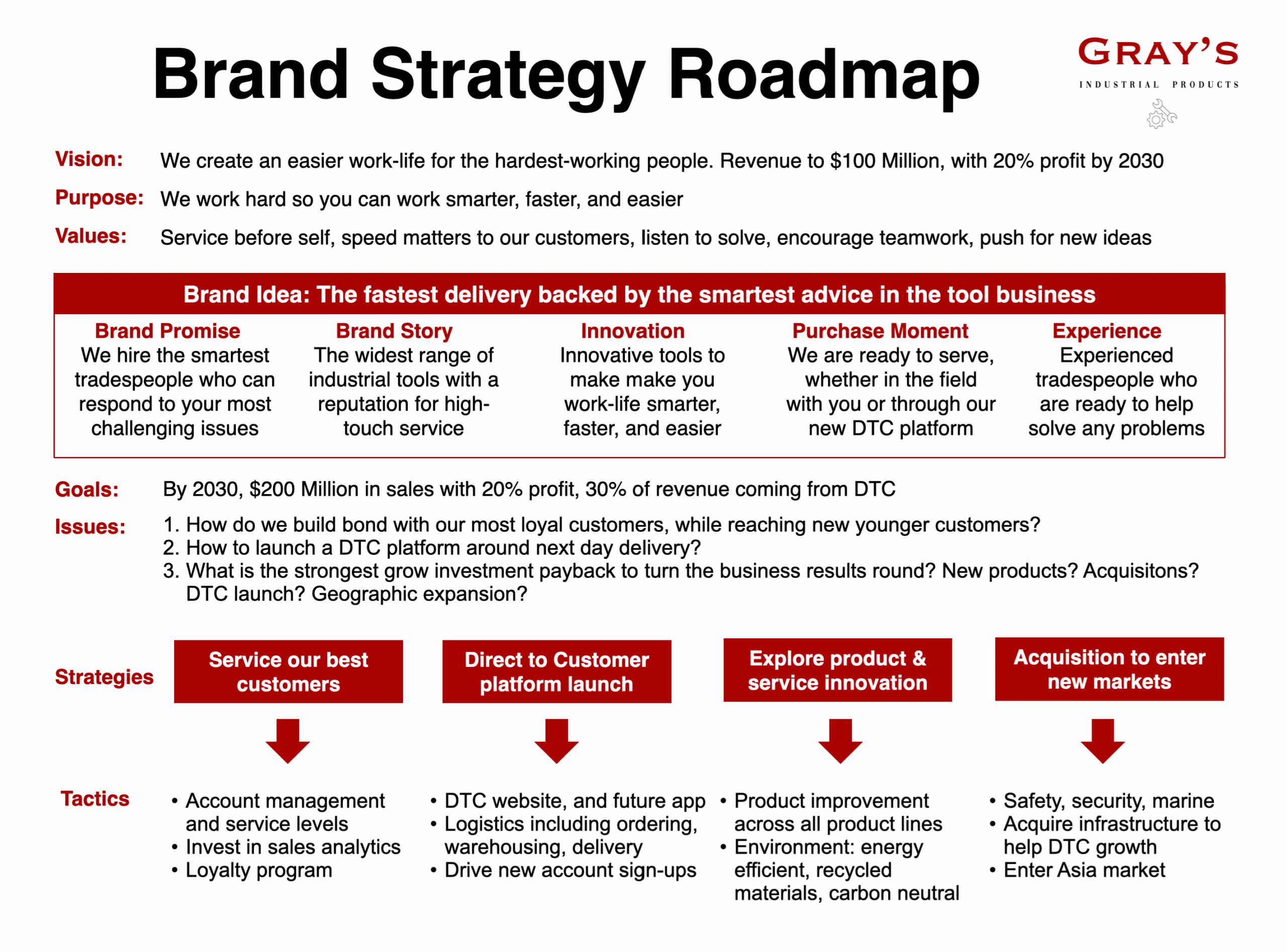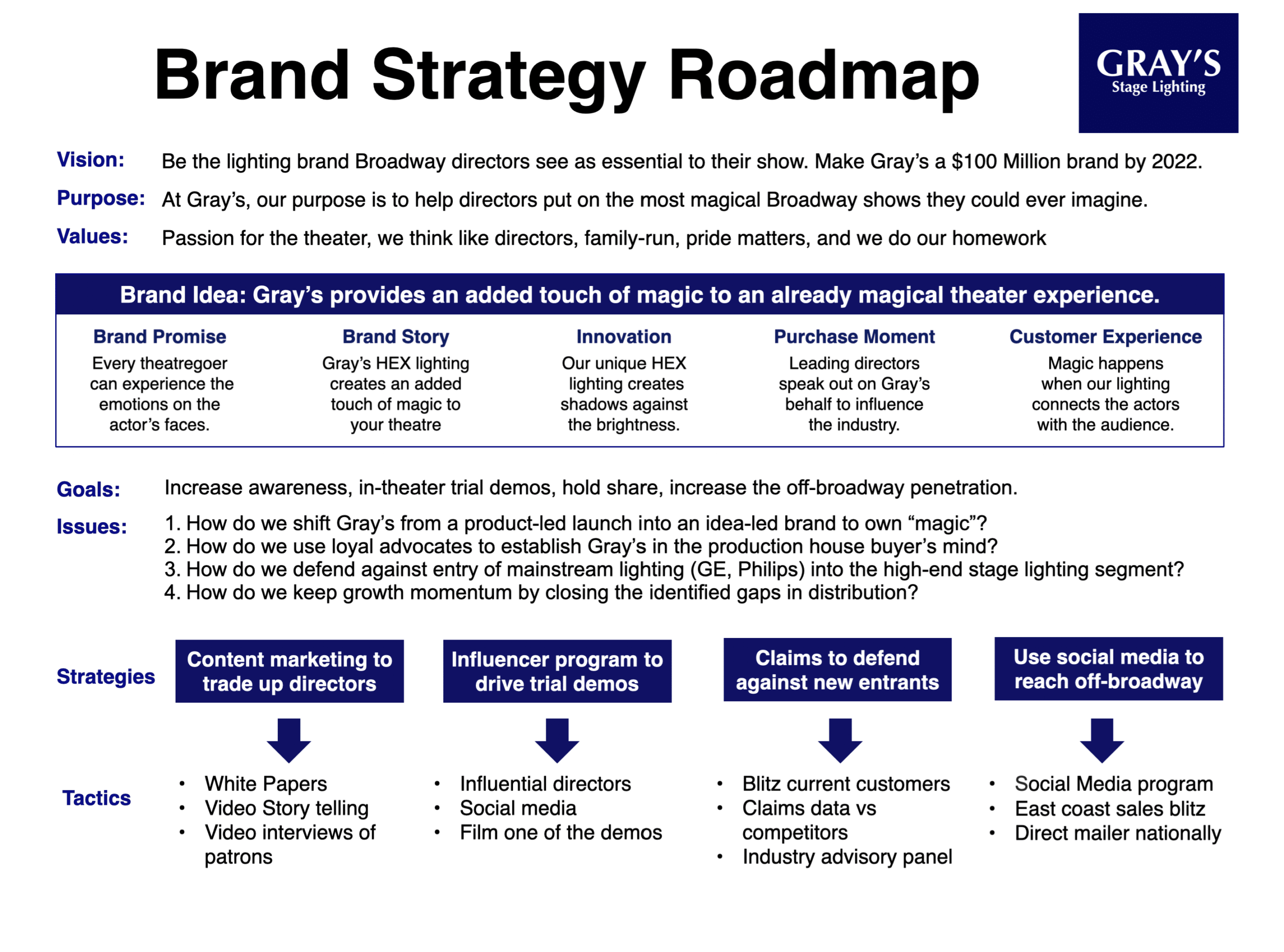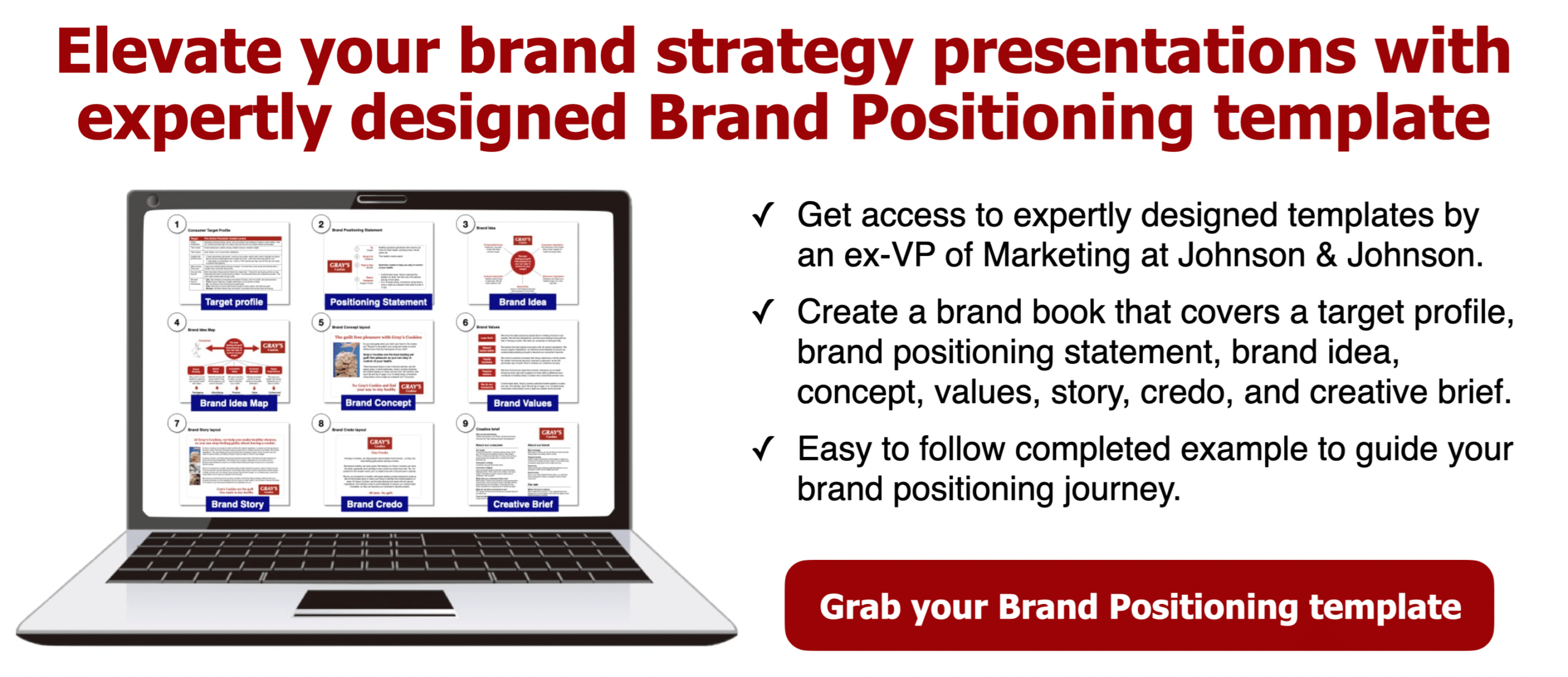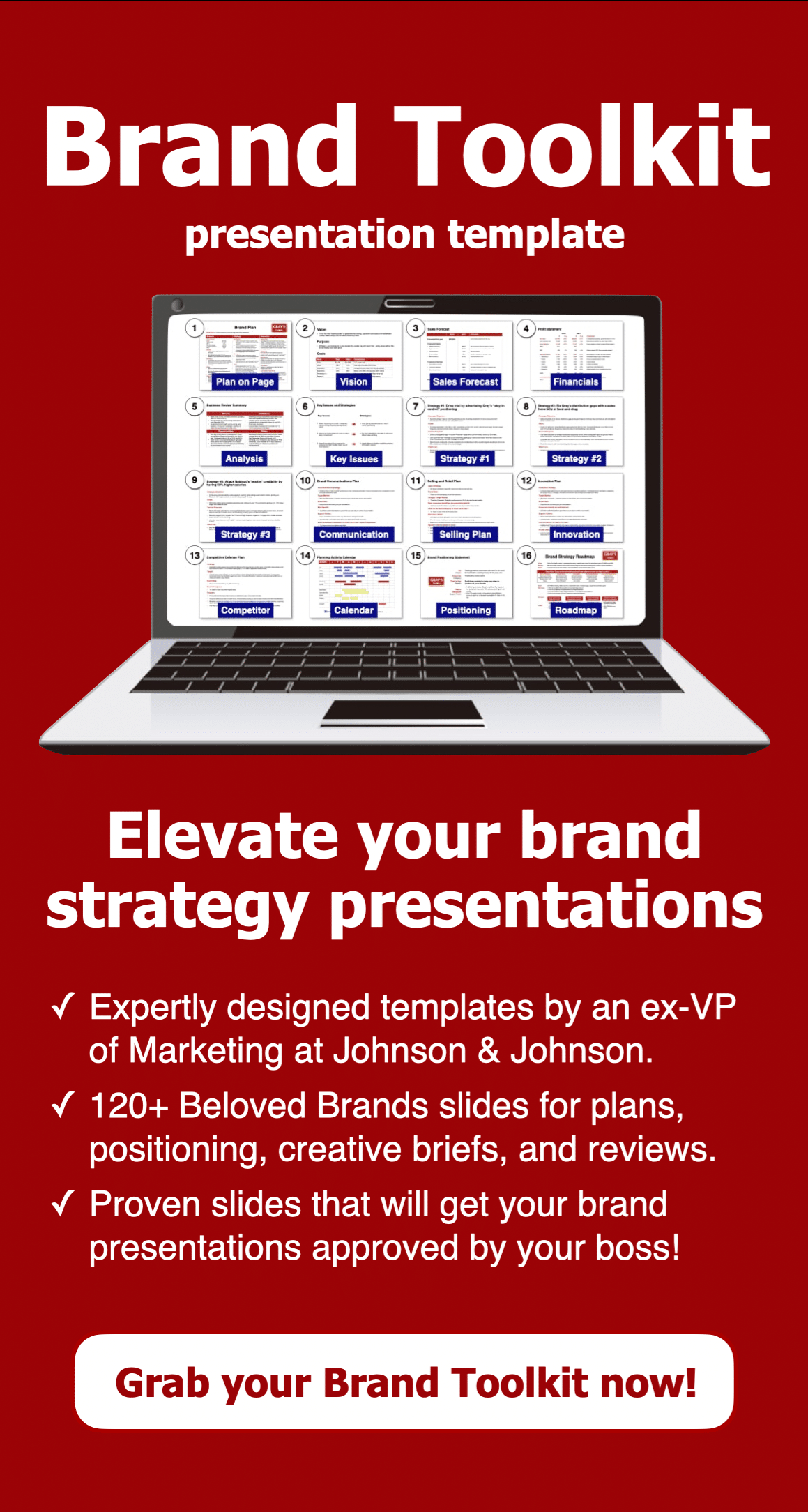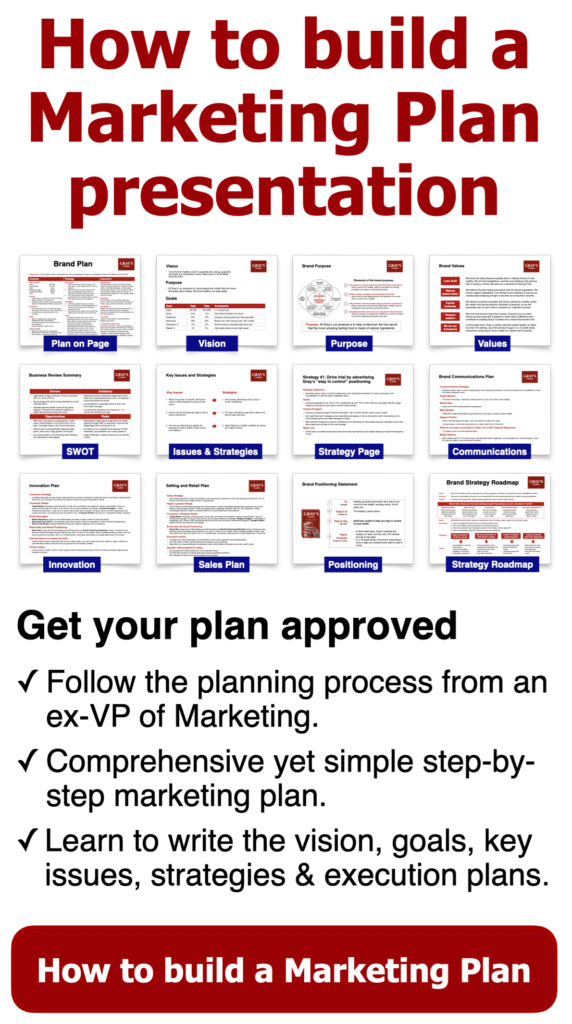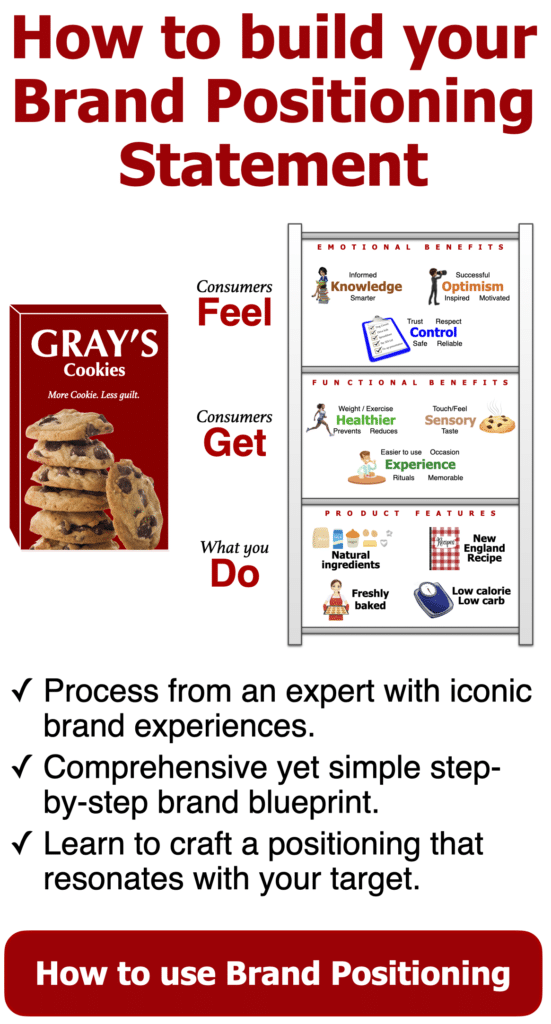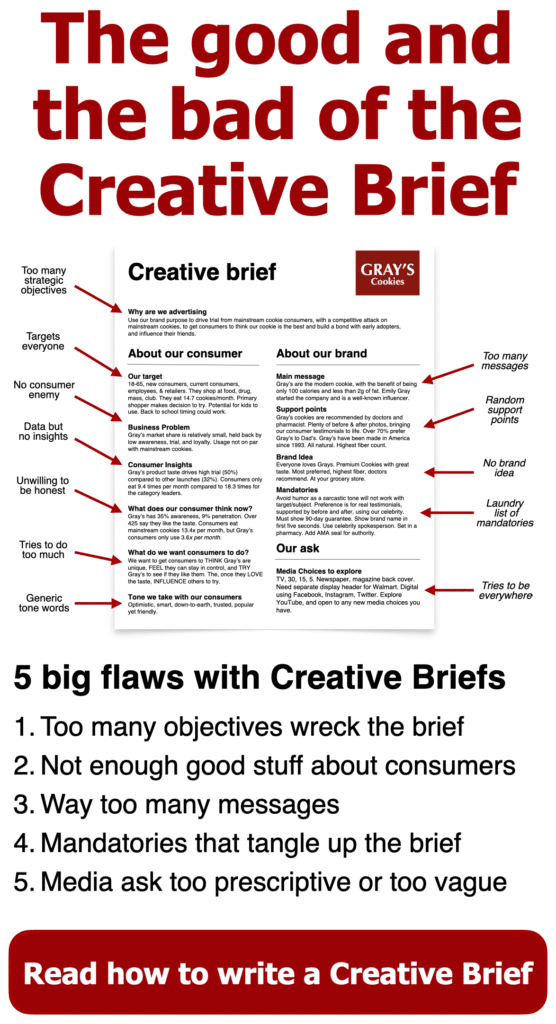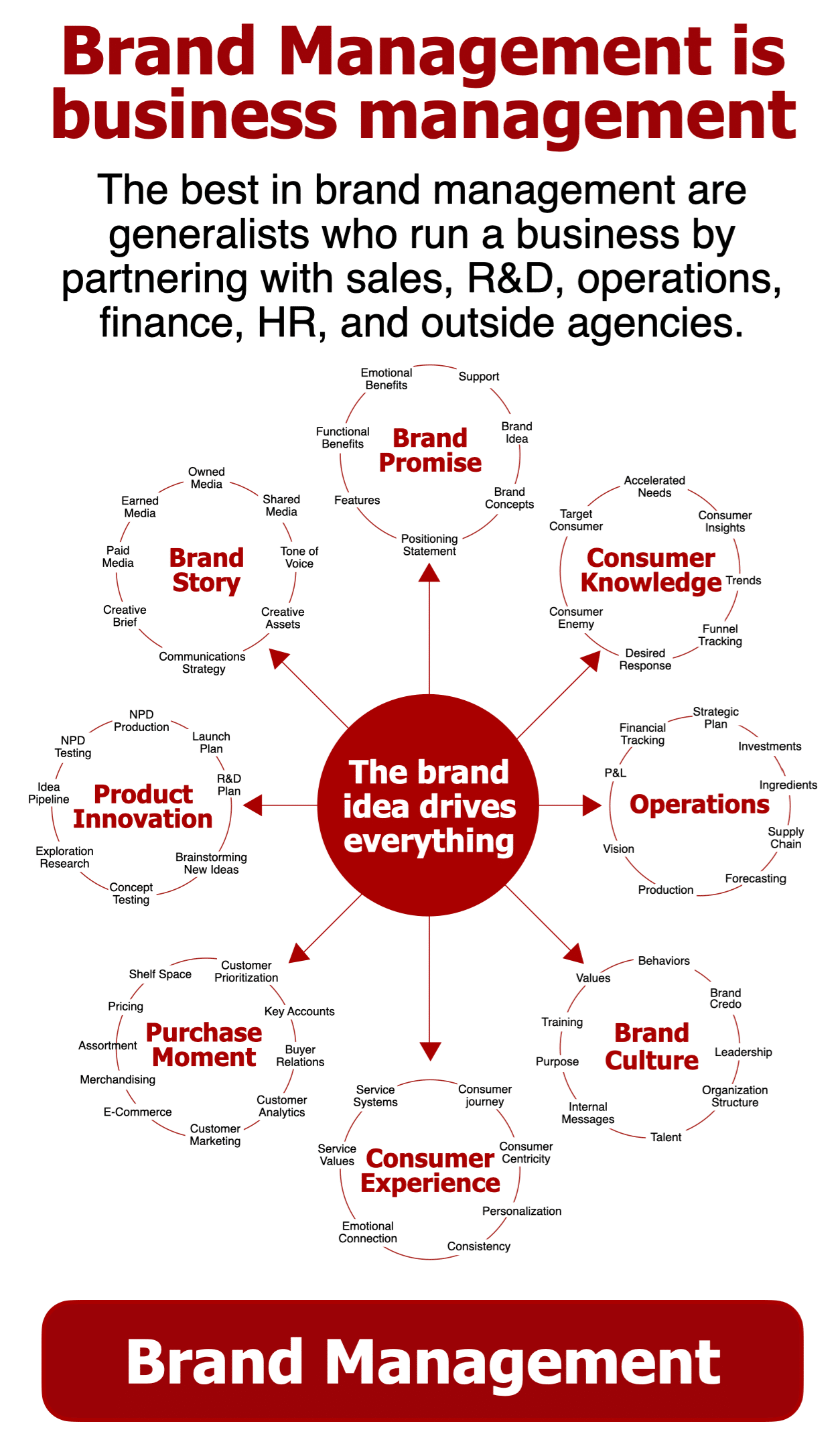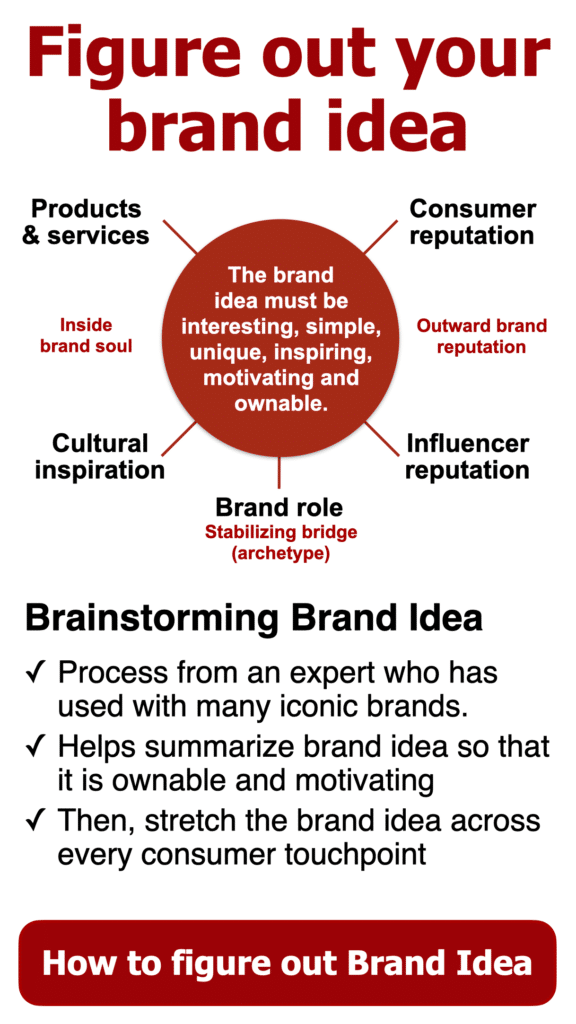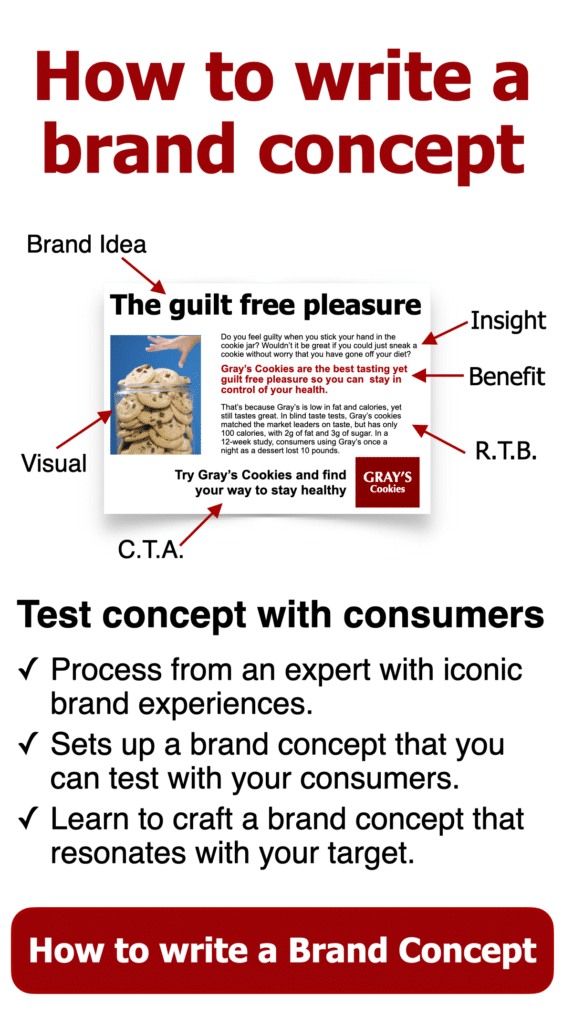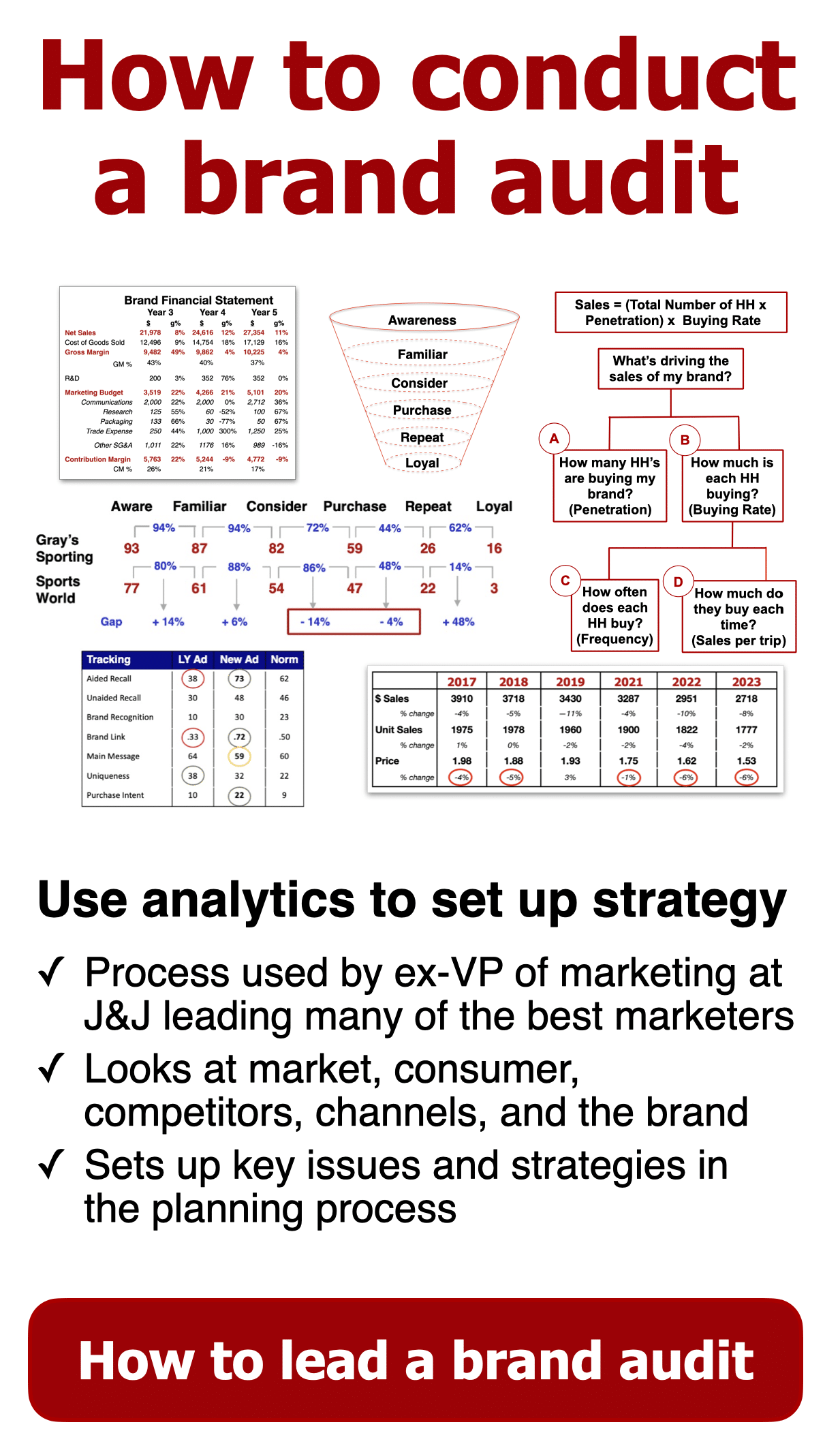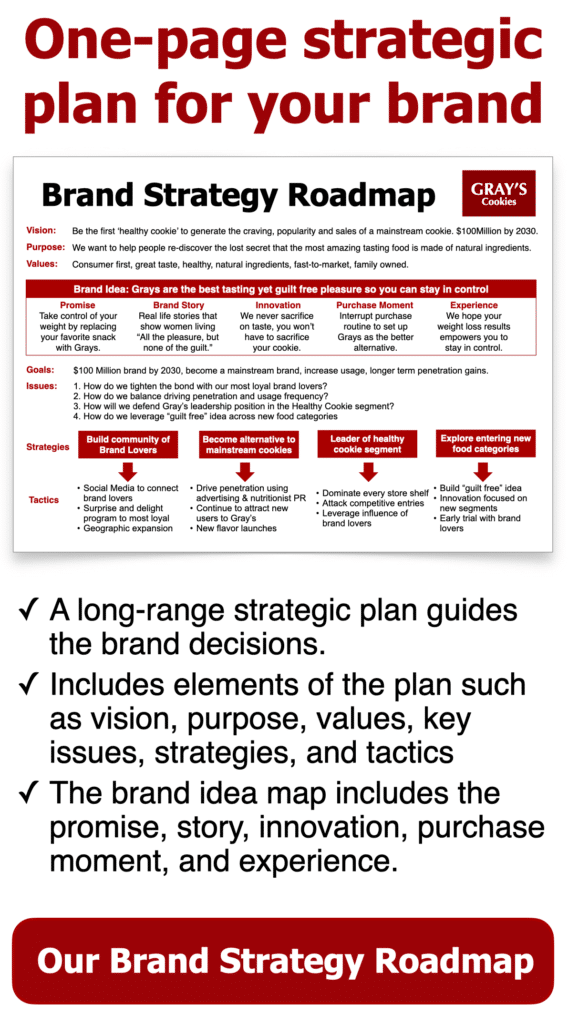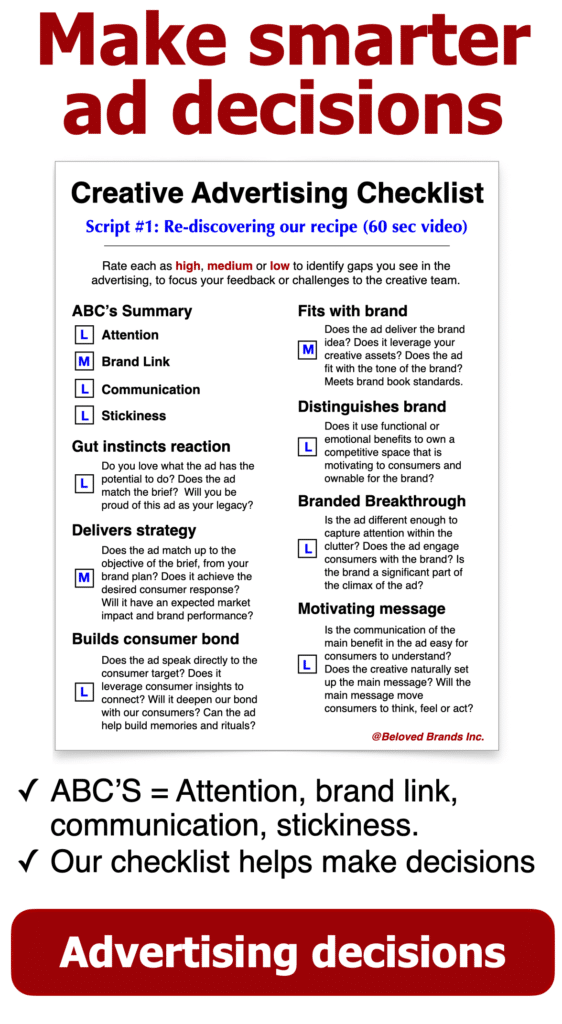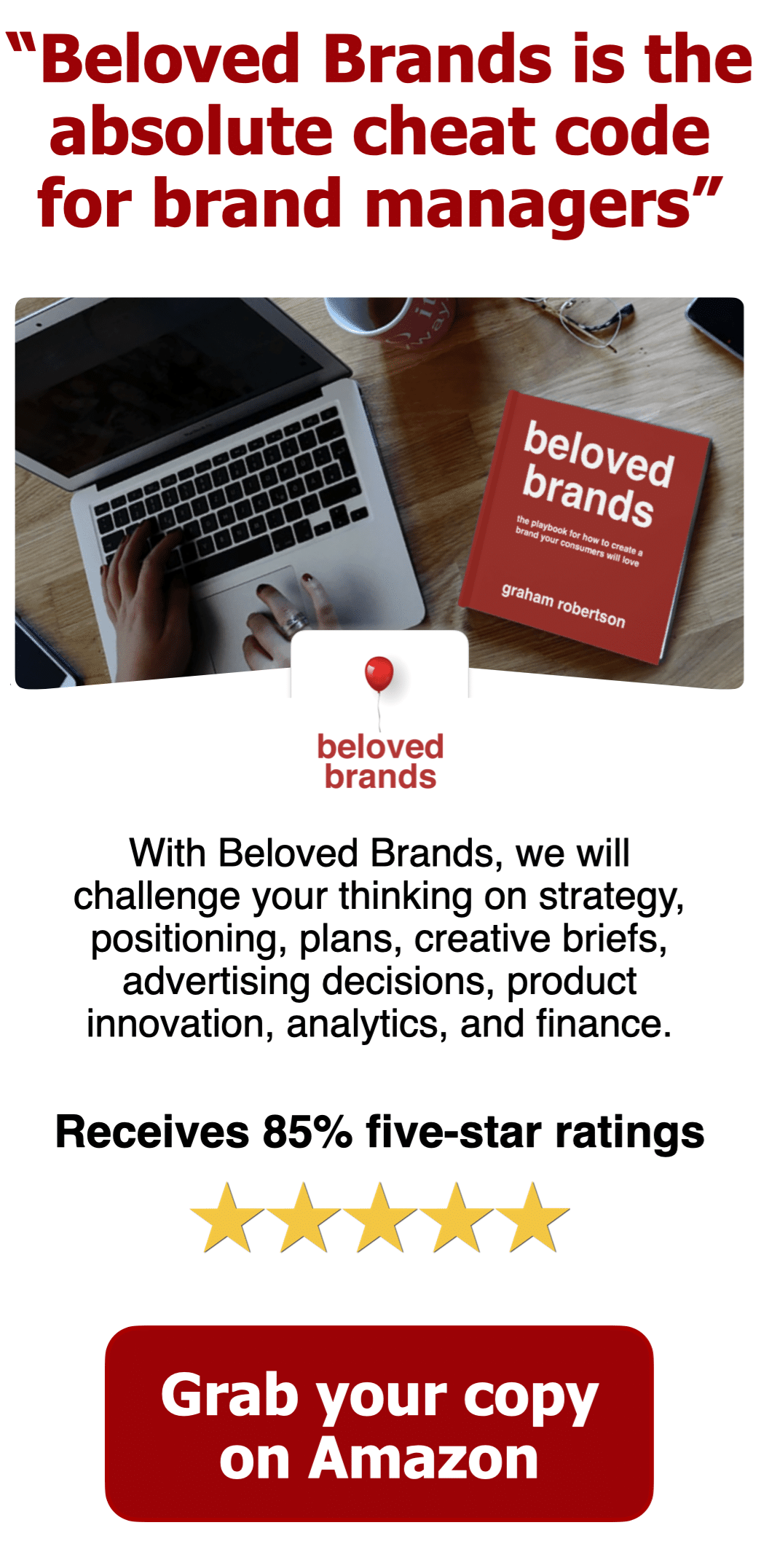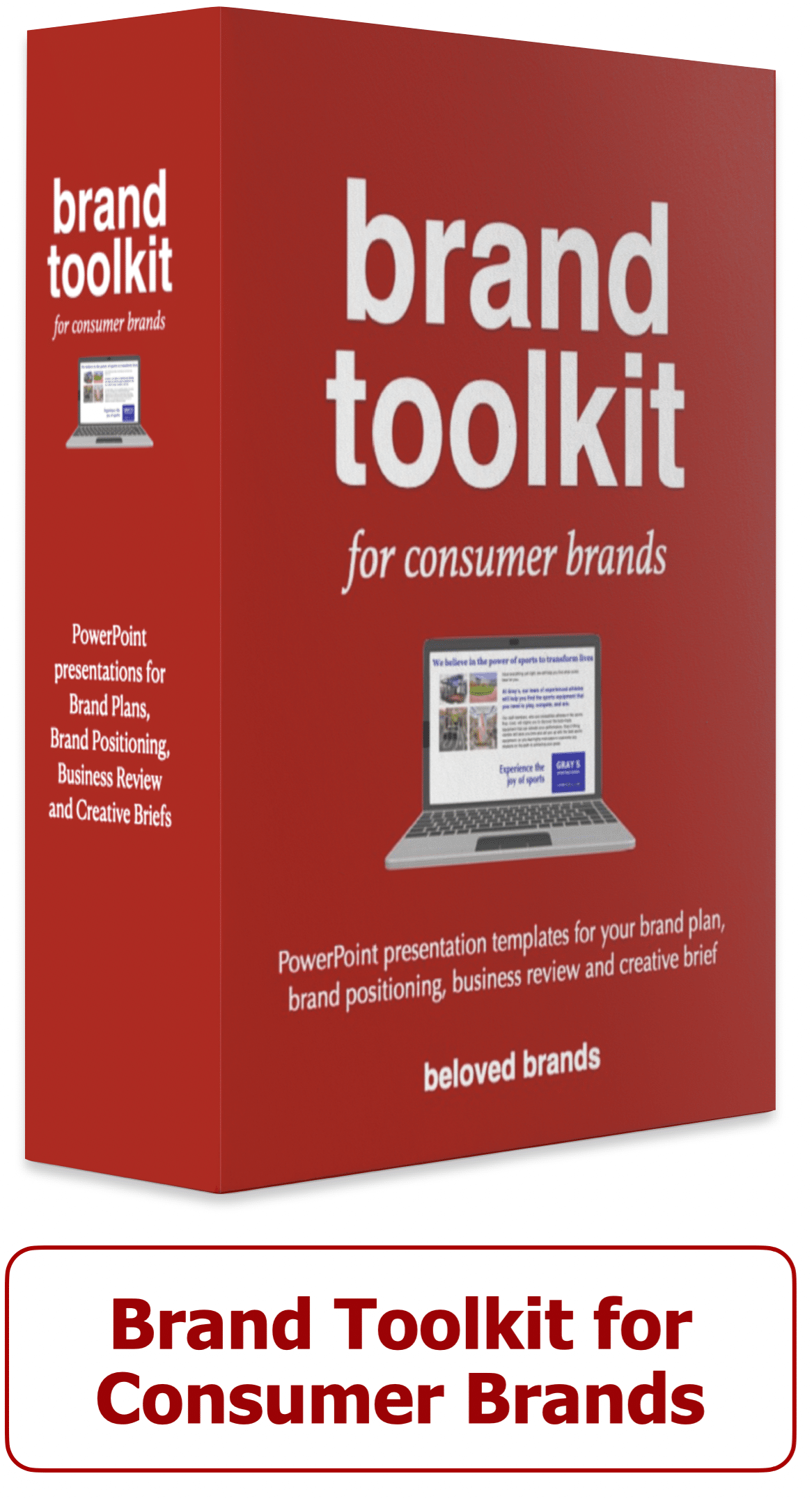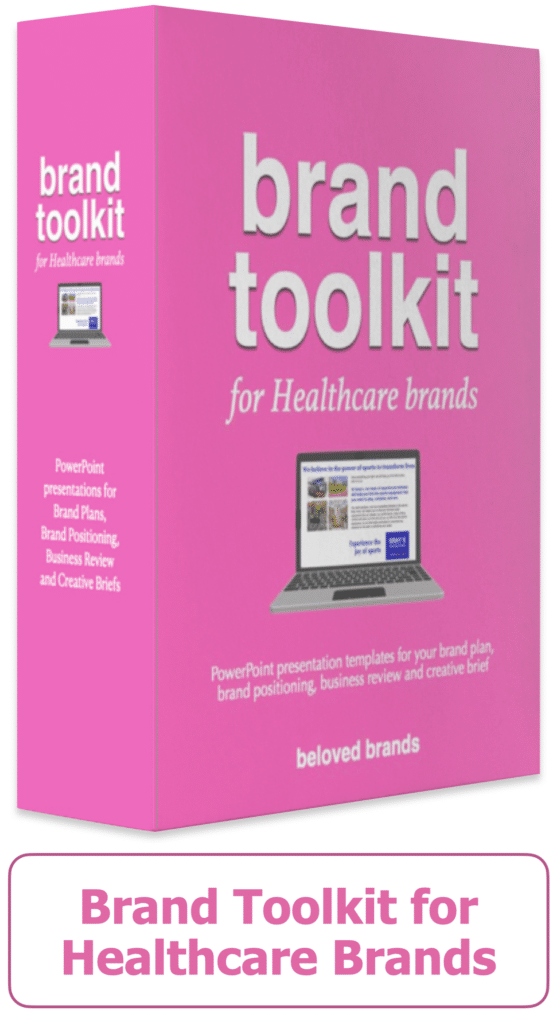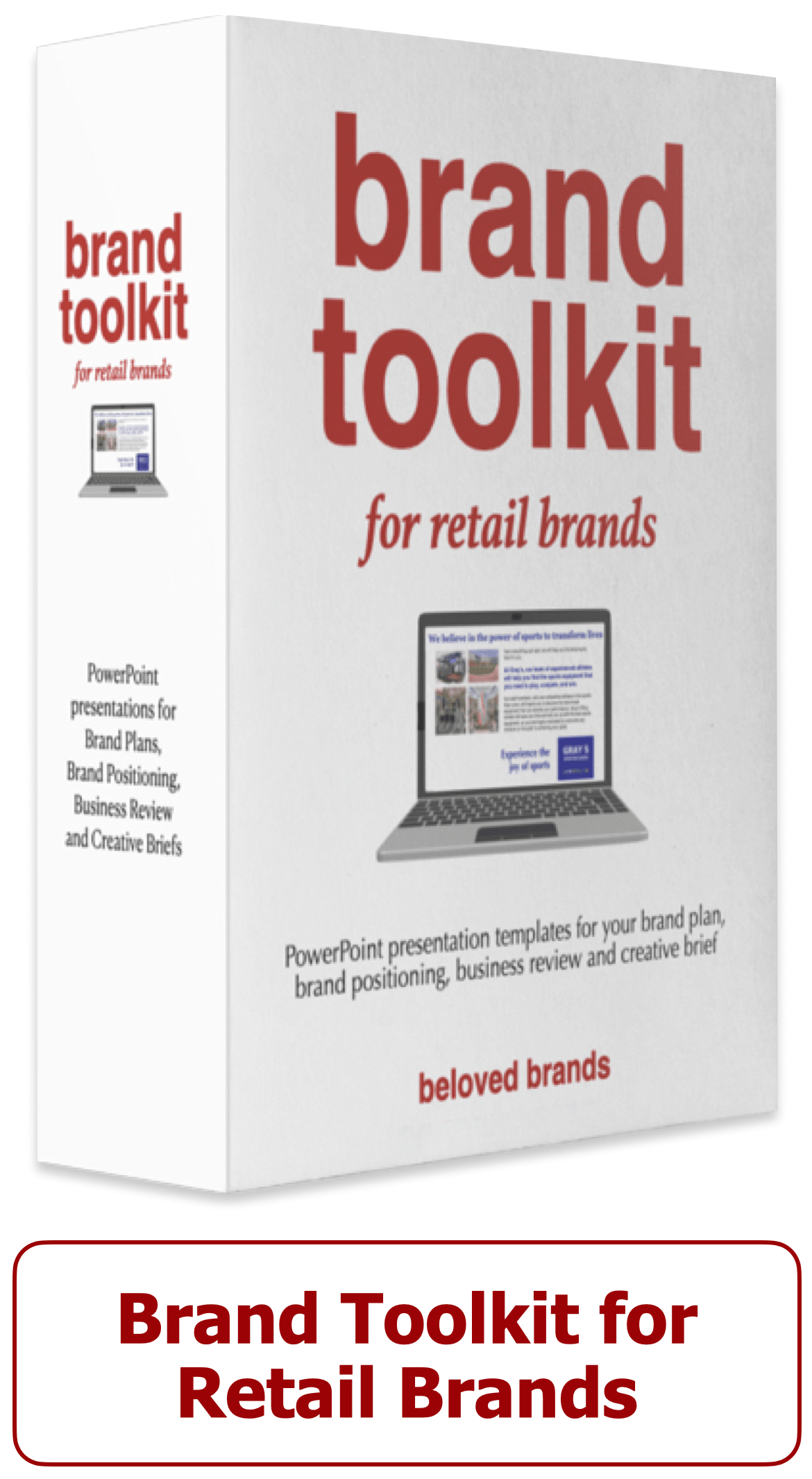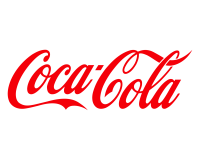Brand strategy decisions must answer, “How can we get there?” Most importantly, strategies must provide clear marching orders that define the strategic program you are investing in, the focused opportunity, the desired market impact, and the payback in a performance result that benefits the branded business. The strategic choices depend on market opportunities to build on your core strength, create a bond with consumers, battle competitors, or line up with your business situation. Every brand should have a long-range Brand Strategy Roadmap document that includes the vision, purpose, values, key issues, strategies, and tactics. Alternatively, some call it a long-range strategic plan or even a Strat Plan.
Brand Strategy
Brand strategy + Brand Idea
As well, the Brand Strategy Roadmap uses the brand idea to deliver a consistent brand across the five consumer touchpoints. These touchpoints that reach consumers include the brand promise, brand story, innovation, purchase moment, and consumer experience.
Your brand strategy should help build relationships with your stakeholders – employees, customers, suppliers, and community leaders. Importantly, I believe branding is an essential part of the business that needs to be aligned with the business goals. To illustrate, read our story on the five steps to building a brand strategy.
To illustrate, click to zoom in on our brand strategy roadmap process.
Strategic Plan template
Vision:
First, the vision in the brand strategy roadmap should answer the question, “Where could we be?” Put a stake in the ground that describes an ideal state for your future. It should be able to last for five to 10 years. Essentially, the vision gives everyone clear direction. Most importantly, the vision should motivate the team. Write the vision in a way that scares you a little but excites you a lot. Importantly, the vision steers the long-range strategic plan.
Brand purpose:
Next, the purpose has to answer the question, “Why does your brand exist?” It’s the underlying personal motivation for why you do what you do. Furthermore, the purpose is a powerful way to connect with employees and consumers, giving your brand a soul.
Values:
Then, layer in values that should answer, “What do you stand for?” Your values should guide you and shape the organization’s standards. Values connect your beliefs, behaviors, expectations, and motivations. Above all, the brand must consistently deliver each value.
Goals:
Your goals in the brand strategy roadmap should answer, “What will you achieve?” For example, the specific measures can include consumer behavioral changes, metrics of crucial programs, in-market performance targets, financial results, or milestones on the pathway to the vision. Accordingly, your goals set up a brand dashboard or scoreboard.
Situation analysis:
Use your deep-dive business review to answer, “Where are we?” Your analysis must summarize the drivers and inhibitors currently facing the brand. As a result, the analysis must discover future threats and untapped opportunities.
Key issues:
The key issues answer the question, “Why are we here?” Look at what is getting in your way of achieving your brand vision. Then, ask the issues as questions. Moreover, these strategies are the answer to each issue.
Brand Strategy:
Next, use your brand strategy decisions to answer, “How can we get there?” Your choices depend on market opportunities with consumers, competitors, or situations. Notably, the strategies must provide clear marching orders. Above all, the brand strategy defines the strategic program you are investing in, the focused opportunity, the desired market impact, and the payback in a performance result that benefits the branded business.
Tactics:
Finally, the tactics answer, “What do we need to do?” Framed entirely by strategy, tactics become action plans with clear marching orders to your teams. Decide which activities to invest in to stay on track with your vision. The best ideas must deliver the highest ROI (return on investment) and ROE (return on effort). Finally, with a long-range strategic plan, you don’t have to get too specific with the tactics.
Beloved Brands Marketing Training
To view, use the arrows to see our Beloved Brands Marketing Training program brochure.
It's time to elevate your marketing team's performance with our Beloved Brands Marketing Training program.
Our marketing training makes your marketers smarter with brand analytics, strategic thinking, brand positioning, brand plans, and marketing execution.
We have the strategy tools to help you build your brand
At Beloved Brands, we have created a Brand Toolkit that includes every slide you need to run your brand. We include our one-page Brand Strategy Roadmap. Equally, if you are looking to build out your marketing plan work, you can engage our Marketing Plan presentation template. Importantly, if you are looking to find the right brand positioning on your brand, we do run consulting workshops with teams to help come up with the ideal solution.
If you’re looking for a marketing book that is actually written by a marketer, I wrote my 𝗕𝗲𝗹𝗼𝘃𝗲𝗱 𝗕𝗿𝗮𝗻𝗱𝘀 𝗽𝗹𝗮𝘆𝗯𝗼𝗼𝗸 to show how to build a brand that consumers will love. At the heart of our book is how to think, define, plan, execute, and analyze. Learn about strategic thinking, brand positioning, writing plans and creative briefs, how to make advertising decisions, brand analytics and finance 101 for marketers.
We are so excited to see so many great reviews of our book, with 𝟴𝟲% 𝗴𝗶𝘃𝗶𝗻𝗴 𝗕𝗲𝗹𝗼𝘃𝗲𝗱 𝗕𝗿𝗮𝗻𝗱𝘀 𝗮 𝟱-𝘀𝘁𝗮𝗿 𝗿𝗮𝘁𝗶𝗻𝗴.
Organizing brand idea
Your brand idea is at the heart of your brand strategy
When we help find your brand strategy, we use a brand idea to represent the inner brand soul of everyone who works on the brand, inspiring employees to deliver the brand promise and amazing experiences. Importantly, the brand strategy must be ownable, so no other competitor can infringe on your space, and you can confidently build your brand reputation over time. Equally, make sure this work is based on your brand positioning statement.
To illustrate, click to zoom in on our brand idea.
Brand Strategy brainstorm
In stage one of finding your brand strategy, we hold a keywords brainstorm for each of the five areas. To start, brainstorm 20-30 words that describe each of the five elements of the brand idea.
Next, in stage two, we turn keywords into key phrases for each of the five areas. Then, get the team to vote to narrow down the list to the best 3-5 words for each section. You will begin to see certain themes and keywords. Take those selected words and build phrases to summarize each section.
To illustrate, click to zoom in on our brand idea brainstorming.
In stage three of our brand strategy workshops, summarize everything to create a brand idea. Once you have phrases for all five areas of our brand strategy model, the team should feel inspired to use their creative energy to develop the brand idea. Importantly, find a summary statement that captures everything around the circle. Try to get a few options you can test with consumers and employees.
Once you have the brand idea, create a brand idea map to steer everyone who works on the brand
We use our Brand Idea Map to stretch the brand idea across all consumer touchpoints. We include the brand promise, brand store, new product innovation, purchase moment, and the consumer experience.
To illustrate, click to zoom in on our brand idea map process.
Brand promise:
Using the brand idea to inspire a simple brand promise separates your brand from competitors. Essentially, position your brand as better, different, or cheaper.
Brand story:
When you use a brand story to bring the brand idea to life, it helps motivate consumers to think, feel, or act while it works and establishes the ideal brand’s reputation to be held in the minds and hearts of the consumer. Above all, the brand story aligns all brand communications across all media options.
Innovation:
Using the brand idea to build a fundamentally sound product helps stay at the forefront of trends and technology to deliver innovation. Furthermore, steer the product development teams to ensure they remain true to the brand idea.
Purchase moment:
Using the brand idea to move consumers along the purchase journey to the final purchase decision helps align the sales team and set up retail channels.
Consumer experience:
Finally, turn the usage into a consumer experience that becomes a ritual and favorite part of the consumer’s day. As a result, the brand idea guides the culture of everyone behind the brand who delivers the experience.
Example of a brand idea map
Below, we use our Brand Idea Map to stretch Gray’s Cookies’ “guilt free” brand idea across all consumer touchpoints.
Now, you can get everyone on the team to keep the Brand Strategy Roadmap and one-page brand plan handy.
What I recommend is to laminate two documents back-to-back. Having both documents on one page keeps everyone focused and aligned on what they must deliver. For more info on our one-page brand plan, click on this link: You will love our one-page Brand Plan
To illustrate, click on the Brand Strategy Roadmap and the one-page Brand Plan example.
Take a look at the key elements in building your plan
To illustrate, click on the Brand Plan presentation above, and use the > to move the slides
Tesla Strategy
Tesla's Brand Strategy
Tesla started with a desire to shift the car market from gas-powered to electric (vision). While most other electric car companies failed, Tesla cars are remarkably different, as they score high for performance and style (focus). Tesla saw an opportunity to break the usual thinking that energy-efficient meant ugly, slow, and always needing a charge (identified opportunity).
Tesla has capitalized on the consumer’s readiness to do something for the environment and has created a movement. So, Tesla took a different approach. They started at the high end to create a strong desire for their beautiful cars.
And then, they moved down to open up to the masses (market impact). Well, the elite mass! Their cars remain a high ticket item. Finally, following the release of the Model 3 in 2018, their quarterly sales jumped 4-fold over two years (performance result), and the stock price is up 10-fold.
To illustrate, click on the Tesla brand strategy.
Tesla's Brand Idea Map
We use our Brand Idea Map tool to show how Tesla stretches their summarized brand idea of “designed for our future” across five different consumer touchpoints. Brand Promise. Brand Story. Innovation. Purchase Moment. Customer Experience. The Brand Idea Map ensures all are lined up to consistently deliver the same Tesla brand. To illustrate, click to zoom in.
- Brand Promise: The leading electric car, backed by simple software, drives high-performance and stylish designs.
- Brand Story: Tesla has built a movement that stands alone with an intense desire from brand fans.
- Innovation: Our engines are designed like technology, and we are always investing in getting better.
- Purchase moment: Simple. Order online, no dealers, sales reps, or negotiations.
- Consumer Experience: Tesla is a statement brand that creates desire and envy among friends.
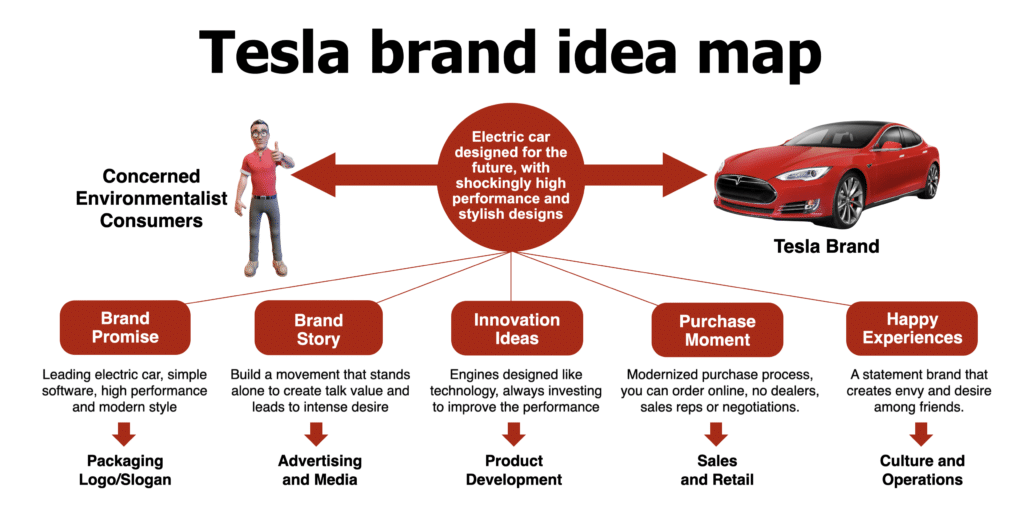
To illustrate, click on the Tesla brand idea map.
Tesla's Brand Strategy Roadmap
With Tesla’s strategy and brand idea map, we can now construct the Brand Strategy Roadmap for Tesla. We include the long-range planning elements of the vision, purpose, values, goals, issues, strategies, and tactics. Then, we layer in the brand idea map elements of the promise, story, innovation, purchase moment, and experience.
To illustrate, click on the Tesla Brand Strategy Roadmap.
Examples of brand strategy
To illustrate, click to zoom in on our B2B brand strategy roadmap example.
Brand Strategy Template
The brand strategy roadmap aligns and focuses everyone
Always look at a long-range strategic plan as an opportunity to make decisions on how to allocate your brand’s limited resources. Apply those resources to the smartest ideas that will drive the highest return. Make the best financial investment choices. Furthermore, the long-range strategic plan forces you to make the best decisions on how to deploy your people.
To illustrate, click to zoom in on our brand strategy roadmap template.
Use the brand strategy to steer everyone who works on the brand
The best brands consistently deliver. Use a cross-functional team, including salespeople, R&D, human resources, finance, and operations. Their participation is one way to gain their buy-in. But that’s not where it stops.
Use your internal brand communications tools to drive a shared definition. Get everyone to articulate how their role delivers the idea. Give the external and internal brand story equal importance to the consumer experience you create for your brand.
Brand Strategy
Does your brand have unrealized potential?
Here are five questions you need to be able to answer about your brand:
- First, can you describe your brand in seven seconds in a way that motivates consumers to engage and in a space that is own-able for your brand?
- Second, are you making the right investments to create a market impact for your brand and lead to a performance result for your business?
- Next, does everyone on your team know their role and how they contribute to building a successful brand?
- Does your marketing execution establish your desired brand positioning and move customers to purchase?
- Finally, are you investing in your people to ensure they make smarter decisions and produce exceptional work that drives business growth?
If you cannot answer these five questions, your team will be confused. Clearly, your brand investments will be scattered and won’t pay back. You will see inconsistent execution in the market. The consumer will not know how to define your brand. And you won’t grow! It is time to make decisions.
We help brands define themselves so they can drive new growth opportunities.
At Beloved Brands, our brand strategy process will help you define your brand and map out a strategic plan for the best possible future for your brand.
We will help you define your brand positioning statement and narrow it down to a brand idea that is your seven-second pitch. Then, we challenge you to select the right strategic investments for your brand and build a strategic plan everyone can follow.
Importantly, you need your marketing execution to build your brand reputation and move customers along their purchase journey.
Brand strategy FAQ
What’s business strategy? What is a brand strategy?
Business strategy forces brands or companies to make choices that define how they will achieve their vision. The five elements of a brand strategy include the vision, investment choice, focused opportunity, market impact, and performance result. We use these elements to build out the brand strategy statement you can use in any plan.
Why brand strategy is important?
The brand strategy aligns the company with a few strategic investments. The brand strategy helps gain approval from senior management, including C-suite and CEOs. And a brand strategy roadmap steers everyone who works on the brand. While it provides the long-range elements such as brand vision, purpose, and values, it lays out the key issues, strategies, and tactics.
Our brand strategy roadmap also shows all those who work behind the scenes how to handle the execution against all the consumer touchpoints. This helps focus the brand’s look and feel, marketing communications, innovation, sales, operations, and culture.
Why have a brand strategy?
Every brand should have a long-range Brand Strategy Roadmap document that includes the vision, purpose, values, key issues, strategies, and tactics. Alternatively, some will call it a long-range strategic plan, a business strategy, or Strat Plan.
What are the four types of brand strategy?
The strategic choices depend on market opportunities to build on your core strength, create a bond with consumers, battle competitors, or line up with your business situation.


